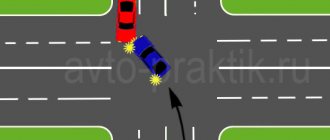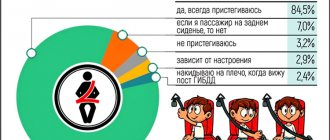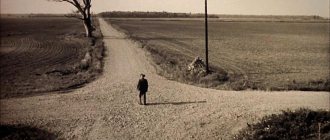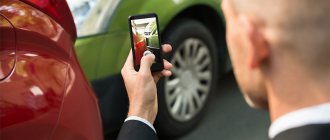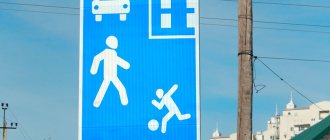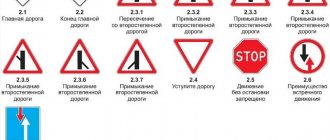One of the types of accidents on the highway is a non-contact accident. It involves creating an obstacle for another motorist, who, in turn, harms third parties, but there is no collision with the culprit. This often happens at intersections where people don’t want to give way, turn around in prohibited places, or try to quickly run through a red light. In such a situation, there is no accident without damage, since the car or road objects are damaged. The difficulty of obtaining compensation lies in the fact that there is no direct confrontation with the culprit. But if you prove his involvement, then there will be no problems with payment.
What is a non-contact accident?
A non-contact accident is a situation on the road when one participant creates an obstacle for another. As a result of such interference, a third party suffers harm: it can be moral, physical or material. In this case, there is no direct contact with the culprit. For example, a driver makes a U-turn in a prohibited place, and an oncoming car moves to the right to avoid a collision and crashes into a tree. The complexity of this type of accident is as follows:
- The culprit escapes from the scene with impunity, and it is not possible to find him.
- Incorrect interpretation of what happened, for which the injured party bears responsibility.
- Difficulty in holding accountable a person who was not injured in an accident.
Attention! If no people were injured and the vehicles are completely intact, then it is not classified as an accident. It will not be possible to obtain moral damages from the culprit. There must be damage, at least minimal. All drivers need to know what a non-contact accident is in order to understand in what situations and how the person at fault should be held accountable.
Features of registration in a non-contact accident
This issue is not regulated in any way by law, so it is necessary to rely on general provisions, as well as established practice. Where should I go to file an accident report? In most cases, in such an accident, drivers are unlikely to be able to reach an agreement and resolve the issue on their own, so they will have to call the traffic police.
After the inspector arrives at the scene, he will begin to establish the circumstances of the incident and try to attract as many eyewitnesses as possible. In such cases, it can be very difficult to establish the driver’s guilt on the spot, so it is quite possible that further examination will be required.
Most often, the inspector’s task in this case is to check the facts of violations, draw up a protocol, and collect evidence. Due to the complexity of the circumstances, litigation is likely. If there are sufficient grounds, the driver may be found guilty of an accident, on the basis of which other participants will be able to immediately demand payments under compulsory motor liability insurance.
ATTENTION !!! A European protocol can also be drawn up if the at-fault driver voluntarily agrees to this. Drivers fill out the form themselves, and traffic police inspectors are not called to the scene. This method is most convenient for minor accidents, when the damage caused is relatively minor.
To register an accident in this way, you must complete the following steps:
- prepare a sufficient amount of evidence in the form of photographs or video recordings. In the future, this will be the main condition for the provision of insurance compensation. This point should not be ignored. The more photographs from the scene of the accident, the better for the driver himself. It is also necessary to draw up a rough diagram of the accident that occurred;
- After photographing is completed, the parties can move their cars to another place so as not to disturb other traffic participants. It is necessary to follow traffic rules and caution so as not to provoke a new accident;
- At the end, a special form is filled out, where all the necessary information is entered. Other evidence and materials are attached to the form. Both parties must sign the completed protocol.
The completed document can be used to receive insurance compensation in the future. It is worth noting that the registration of a European protocol can only take place on a special form; any form is not allowed. Since 2021, new forms have been introduced, and therefore the old ones have lost their validity.
Nuances of an accident without contact
A characteristic feature of a non-contact road accident is the absence of damage to the person responsible for the accident, since he only provokes it, but does not participate in it himself. In this case, lawyers help the driver achieve justice. Recordings from a DVR will be a big advantage. In addition, it is important to ensure that the protocol does not indicate that the driver decided to perform a maneuver instead of braking. In this situation, there will be no recovery from the culprit or compensation from the insurance company. Why does a non-contact accident happen:
- Aggressive driving style. There are a number of drivers who move along the road, paying little attention to other road users, which leads to accidents.
- Incorrect distance selected. When the distance to the nearest car is too short, it is difficult to take measures to prevent a collision.
- Speed limit violation. Driving too fast, overtaking on narrow roads, all this leads to the fact that other motorists are forced to avoid collisions in dangerous ways.
- Failure to comply with traffic rules. The most common reason. Most often this is driving through a red light, overtaking on a closed turn, and more.
Non-contact accidents are regulated by the same provisions as other types of accidents on highways. Therefore, the design rules must also be followed. If damage is received in the form of damage to the car, and the second participant agrees that he is at fault, it is not necessary to call traffic police inspectors. If there is a mutual decision, a European protocol is drawn up. According to it, you can receive compensation of no more than 100 thousand rubles.
Design rules
An accident without direct contact is registered in accordance with the general procedure. After the incident, the parties must stop the vehicles, get out of the cars, and assess the approximate amount of damage received. According to the provisions of the traffic rules, an emergency sign is posted at a distance of 15 m in the city, and 30 m outside the populated area. If there are victims, you must call an ambulance and notify the traffic police about the incident.
Advice! Before the inspectors arrive, it is necessary to take photographs or start video recording, interview witnesses, and provide first aid to the victims. All testimony will be entered into the protocol later. It is strictly forbidden to leave the scene of the accident, try to catch up with the culprit, or resolve everything peacefully when there are people with injuries.
How is the culprit determined?
Since there is no physical contact between the vehicles, it is most difficult to determine who was at fault in the accident. The most reliable evidence is video recording on the recorder, but if there are no license plates, then bringing the driver who fled the scene of the incident to justice will be quite problematic. Law enforcement agencies are involved in this. What is the difficulty:
- The culprit created an obstacle and fled the scene of the accident.
- The victim was held accountable due to an incorrect interpretation of clause 10.1 of the traffic rules.
- The obstacle was caused by a pedestrian crossing the road in an inappropriate place.
- A wild animal provoked an emergency situation.
It is important to know! If the owner of the vehicle is a legal entity, then the victim recovers the payment from him. An auto technical examination can prove the guilt of a particular driver.
Arbitrage practice
In the event of an unlawful refusal to provide compensation by the insurer, the injured party can collect all evidence of the organization’s client’s guilt and contact law enforcement agencies. According to judicial practice, the result of such actions can be very different.
The outcome of the proceedings may be either an admission of guilt on both sides or full satisfaction of the claim filed by the victim. In order for the court to hold only the culprit of the traffic accident accountable, it is necessary to prove a direct connection between the damage caused and his illegal actions.
Often victims win their case with the help of a professional lawyer. You should not overestimate your strength, since during a court case it is very important to correctly provide all the evidence.
Responsibility for leaving the scene of an accident
Leaving the scene of an accident by the perpetrator of a non-contact accident is a fairly common situation. In this way, many try to avoid responsibility. But this action entails unpleasant consequences, which are expressed in the following punishment:
- Deprivation of a driver's license for up to 1.5 years.
- Administrative arrest for 15 days.
- A fine in the amount of six months' income.
Therefore, it is strictly forbidden to leave the scene of an accident if an incorrect maneuver causes a collision between another traffic participant and a pole or second car. Then the consequences will be more serious than the punishment determined for a non-contact accident.
Deprivation of rights for a non-contact accident
The same standards apply to non-contact accidents as to other types of accidents. In this regard, a driver’s license can be revoked in the presented type of incident on the same grounds as in accidents with a direct collision of vehicles.
Rights can be deprived (Resolution of the Armed Forces of the Russian Federation No. 78-AD15-4):
- If the guilt of one of the traffic participants is proven.
- If during a non-contact accident there was harm to health or a threat to the life of individuals.
- If the driver, who, by failing to comply with the established Traffic Rules, created an emergency situation as a result of which an accident occurred, left the scene of the incident.
Additional information
In the case where the driver of the car who caused the interference unintentionally drove away from the scene of the accident (did not notice that he was the culprit of the incident), he can avoid being deprived of his driving license if he provides convincing arguments for his model of behavior.
Will there be compensation from the insurance company?
Many drivers are interested in the question of whether a non-contact accident is subject to compulsory motor liability insurance in order to receive payments. There is no definite answer here, since everything directly depends on the correctness of the documents, as well as bringing the culprit to justice. In many cases, the insurance company refuses because the driver hits a pole and there is no clear evidence that a third party was involved.
Due to an incorrect maneuver by another driver, motorists often crash into poles or fences. Then you should not count on payments, since the actions are considered illegal. It will be possible to achieve compensation only in a situation where the examination issues a conclusion that reflects that it was technically impossible to avoid such a collision. That is, the cause-and-effect relationship with the actions of the culprit and the result obtained must be documented.
It is important to know! It is also important what is written in the traffic police report. If it indicates the culprit and the victim, then payment for a non-contact accident is received within the framework of compulsory motor liability insurance. The issue of compensation can be resolved immediately if the other party did not flee the scene of the incident. But this happens extremely rarely.
Payments under OSAGO
You need to take into account all the points (correct preparation of the necessary documents, collection of evidence, etc.), but also understand that in many cases of a non-contact accident, the insurance company may refuse to pay compensation.
The participants' insurance companies will say they are not obligated to pay for the damage because the driver hit the object.
Drivers whose vehicles were not damaged by other vehicles at the time of the accident may be unlucky.
Usually, a driver who tried to avoid a collision with another car still ends up in an accident due to the wrong maneuver of another participant. Insurers may recognize his actions as illegal, and the driver will not be able to count on payments.
You can receive compensation only when an expert examination establishes that in the accident the driver was technically unable to avoid the collision.
Those. The motorist must prove the existence of a cause-and-effect relationship with the actions of the second motorist and the consequences that occurred.
But, judging by practice, you should not hope for compensation for damage received in a non-contact accident.
Insurance compensation will depend on correctly drawn up documents . If the protocol drawn up by the traffic police at the scene of the accident indicates the culprit and the victim, the driver will be able to receive payment.
The same applies to direct settlement of losses. Those. The driver may receive payment from his own insurance company rather than from the at-fault party's insurer. Such payments are made much faster.
But such payments are possible if two vehicles were involved in the accident. In a non-contact accident, a third party is also involved, so payment of damages is not provided in this case.
If the insurance company refuses, the only way out is to seek compensation for damages in court. There are many such cases in judicial practice regarding non-contact road accidents. To defend your case, it is necessary to collect testimony from witnesses, documentary evidence, photos or video materials.
How to collect?
If you are denied payment, go to court . Judicial practice shows many different examples of settlement of non-contact accidents.
Let's look at one of the cases. A vehicle crashed into a pole due to a maneuver by another motorist. The insurance company refused to pay, citing the fact that the driver did not take into account dangerous weather conditions and did not slow down. The motorist insisted on conducting an examination, which established that the driver did not have the technical ability to act differently. According to the court decision, the insurance company paid compensation.
Another example is when a truck trailer hit a heavy branch on a tree, and a car parked under the tree was damaged. The insurance company also refused to pay, saying that the driver left the car in a dangerous place. But the court recognized the case as an insurance case, and the driver was able to repair his car for free.
But quite often the court decides that the fault is mutual, then insurance compensation is paid in smaller amounts. Keep track of what facts the traffic police officer records during an accident.
If the court refuses, go to the Supreme Court . In determining the guilty party, the Supreme Court may rule that the lower courts were in error.
The interaction of sources of increased danger means a collision of vehicles, as well as other types of interaction (Civil Code, Article 1079).
There may be no direct contact in an accident, but responsibility for causing damage lies with the culprit. Those. a decision to refuse compensation is considered illegal.
But you should also take into account Article 14 of the law on compulsory motor liability insurance, which states that the victim can make claims for compensation to the insurer only in accordance with the established procedure.
Those. the damage was caused only to cars, and the interaction occurred between vehicles with a valid MTPL policy.
Features of a non-contact accident
Let us recall the features of a non-contact accident:
- There is always a party that caused the accident, but was not directly involved in the collision of cars.
- Very often, a motorist who creates an obstacle and becomes the culprit of an accident leaves the scene of the accident without waiting for the arrival of traffic police officers. Materials from the video recorder will help identify the culprit.
- When drawing up a protocol, it is necessary to correctly interpret clause 10.1 of the traffic rules and not indicate that the driver braked due to the threat of a collision instead of performing a maneuver. Such an entry in the protocol will lead to the injured driver being found guilty.
- Non-contact accidents are subject to the same laws as other types of accidents.
- This is an insured event, but in order to receive compensation payments, you must comply with the rules for registering an accident.
- The rule on direct compensation for losses does not apply to this type of accident. The victim must apply for compensation from the insurance company at fault.
In case of a non-contact accident, it is quite difficult to obtain compensation payments . Often, injured motorists are rejected by insurance companies, and drivers have to prepare documents to go to court.
But spending time and money on legal proceedings is pointless if the driver does not have evidence of the guilt of another person: testimony of witnesses and recordings from the DVR.
It is also necessary to monitor what information about the incident is entered into the protocol by the traffic police officer who arrived at the scene of the accident.
Going to court
You can defend your rights and demand compensation for damage received in a non-contact accident in other ways.
Where to go if the insurance company refuses: to the court, presenting all the evidence that you have on hand. Practice shows that in this case there are more chances to achieve a positive decision. When writing a statement of claim, it is necessary to focus on the existing evidence that you are right. This is a protocol issued by the traffic police, video recorder recordings, and written evidence from the parties. The court considers all the circumstances of the case and makes a decision based on the existence of violations of rights. A non-contact accident is a complex situation on the road that arose due to an unsuccessful maneuver. Even the Supreme Court interprets the definition in its decisions. The culprit is not directly involved in the collision, but only provokes it. The complexity of such a case lies in the fact that it is extremely difficult to hold the other party accountable, as well as to obtain compensation. But if you know the basic rules for determining the culprit, then you will have a greater chance of effectively protecting your rights.
